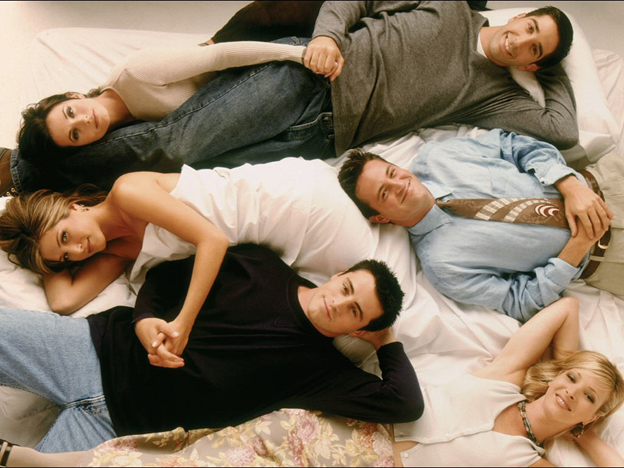The Economics of Friends
September 28, 2011 in Editorial, Top

Friends is widely regarded to be one of the best television shows in history. With constant reruns in the United States and the rest of the world it’s clear that the show still has a significant cultural impact. The series which aired from 1994 to 2004 features the lives of six friends living in Manhattan. The show follows them through the tumultuous twenties and early thirties of dating, marriage, divorce, kids, and career changes.
How would the six fare living in Manhattan in today’s day and age? Centives decided to find out. To estimate the income of each of the characters Centives used data from the New York Bureau of Labour Statistics. Rachel is unsurprisingly the poorest member of the group. As a waitress she would expect to make $19,570 a year. If we classify Joey as a part time actor and assume that he makes $26.95 an hour then he would make $28,028 a year. This is a couple of hundred dollars less than what Monica would make as a cook at a restaurant ($28,280). At the New York Museum of Prehistoric History Ross would make $49,590.
What is perhaps most surprising is that as a massage therapist Phoebe ranks second among the friends in terms of income and would be expected to make $50,060 a year. In the pilot episode she is seen playing the guitar for change in the NYC subways. Yet there is ample reason to believe that Pheobe understates her income. Phoebe claims to hate corporate massage chains; yet it turns out she works for one of them “for the cash” and that clients pay $100 per session (plus tip). In other situations she’s more than happy to use her tortured childhood as an excuse for things as trivial as a blueberry muffin. It is within the realm of possibility that she was only pretending to be poor the entire time in order to win sympathy from her group. She is, after all, the character whose personal life we know the least about.

Chandler’s hatred for his job is surpassed only by the amount of money he makes from it. With an annual salary of $68,440 he is by far the richest of the six.
Ten years later, in the show’s final season some of the six have moved up a few income brackets. Chandler is the only one whose salary very slightly decreased when he went from being a database administrator to an advertising sales agent. Phoebe and Joey end the show in the same positions that they started at. Going from cook to head chef has increased Monica’s salary by 44%. Ross almost doubles his salary when he goes from working at the museum to being a professor at New York University. The big winner though is Rachel who goes from being the poorest of the six to being the richest. The progression from waitress to senior executive at Ralph Lauren means that she ends up making five times as much as what she did when she first started her career.
One of the most common criticisms made about the TV show is that it is unrealistic in its depiction of the type of living standards that the six Friends enjoy. Would it be conceivable for the six of them to live the type of lifestyle they do in today’s era? With the exception of Monica the Friends change apartments for an extended period at least once. But most of their residences have some features in common. They are almost all located in Greenwich Village. And they almost always have two bedrooms and one bathroom. Most of the time each apartment is occupied by two roommates.

According to Zillow, a property value website, in the past twelve months, the average monthly rent of the five cheapest listed properties that had two bedrooms and one bathroom in Greenwich Village was $2,200. Assuming that the rent is divided equally between the two roommates, this comes out to $13,200 per year per person. All six of the Friends could afford this. However for some such as Joey, Rachel, and, Monica in the first season this leaves very little money for food, transportation, and other living expenses.
The estimate of the rent is also an average of the five cheapest properties available on Zillow. The accommodations of the Friends are generally much nicer. That would suggest that Centives has underestimated how much they had to pay in rent. On the other hand though the TV show mentions that at least Monica’s apartment benefitted from rent control. That would indicate that Centives overestimated the amount that they paid in rent. Whichever case is true the approximations provided here work well as ball park figures.
The stunning career progression of characters such as Rachel might be unrealistic. Or perhaps it harkens back to an earlier era, an era in which the American dream of upward income mobility seemed to be within reach, and it wasn’t absurd to think that a waitress could become anything she wanted. And perhaps no amount of legal loopholes could justify the relative luxury that the Friends find themselves in. But each episode was quick to remind us that no one told you life was gonna be this way, and even if your expectations end up clashing with reality, your friends will be there for you.
It’d be difficult to find people who disagree.
Follow Centives on Twitter
What is so surprising about Rachel’s increased income? She has a college degree. She only took the waitressing job because she decided to stand on her own all of a sudden!
Phoebe starts working at that corporate massage chain which allows her to wear better clothes and bleach her hair. She likely makes upwards of $60k a year. Her season 1 salary should be less than 40k since she doesn’t pay taxes until she starts working at the corporate massage chain.
Joey likely also makes a lot more than $28k a year with the Days of Our Lives (Season 10) since he is able to lend people money and he is not a spender at all. Furthermore, he was very broke when he wasn’t acting (in plays that obviously paid so little that he had to keep borrowing Chandler’s money). On DOOL, Joey’s salary as a TELEVISION Soap-Opera Star should have been at least $100k per year.
There is one particular episode near the beginning of the series in which Ross, Chandler, and Monica are depicted as having money and Rachel, Phoebe, and Joey are depicted as having little. So I think it’d be safe to say that Phoebe was making less than 50K/yr at the beginning.
When Chandler is offered his unpaid internship at the advertising agency Phoebe mentions that she knows that Joey makes the most money out of the six of them.
By the end of the show, Joey is by far the richest–he’s a popular soap opera star, and has done a few high-profile projects starring along A-listers (the big-budget World War I epic, the play with Jeff Goldblum). He also loaned Monica and Chandler $4,000 without batting an eye.
Rachel, Ross, and Chandler’s salaries all look pretty accurate, although it’s possible that Rachel makes more and is higher ranking than we gave her credit for, considering how spacious her office is; I have a friend who works in fashion as a junior executive at a smaller company, pulls $90k, and has a tiny windowless office with modular walls. Chandler also has a substantial amount of savings from his past job, and his mother is loaded: she’s a romance novelist famous enough to get on Jay Leno. Danielle Steel has a net worth of $375 million–it’s conceivable that his mother is worth tens of millions at least herself, which could mean she kicked money his way or he has a trust fund.
Phoebe, meanwhile, “went corporate” at some point during the series. I have no idea how much a corporate masseuse makes, but she herself states she does it because the moneys’s good and she gets benefits. She also inherited her grandmother’s cab and, while she kept the car itself, she’s never seen taking passengers so it’s likely she sold the medallion–which could net almost a million dollars. And her husband, Mike, also comes from family wealth.
Monica, too, makes more than $40,000 by the end of the show. When the show starts off, she’s a sous chef at a nice restaurant, and she has some ups and downs before landing her job as executive chef at Alessandro’s. At the beginning of season 9, she was hand-selected to be the executive chef at a top restaurant that books up weeks in advance, and as such is making substantially more than the average chef. Plus, considering she’s only about 32 by the time she gets hired, that makes her quite the up-and-comer.
As for apartments, it’s worth noting that today’s $2,200 doesn’t reflect prices from 25 years ago. These characters would’ve all moved into the city (and, presumably, the apartments they were living in during season 1) in the late 1980s, before gentrification really hit Greenwich Village–it would’ve still been an artsy area in a decaying city, and rent would’ve been much more affordable. Throw in the facts that: Phoebe and Monica both lived in their grandparents’ apartments, which would’ve been rent-controlled going back decades, meaning these apartments would have been really cheap even back then; Joey and Chandler’s apartment was pretty run-down at the beginning, and was probably “a deal” in an era where deals still existed in the Village; and that Ross had (I think) a one-bedroom until season 5, and these apartments don’t look quite as out-of-reach.
As someone who works in restaurants in the city, a sous chef at a mid-priced restaurant ($$ on yelp) in Manhattan can make about 35-50K a year depending on experience, skill, the amount of work involved, and how much revenue the restaurant actually brings in. Sous chef is a managerial position and it pays far, far better than being a line cook. At nicer restaurants ($$$ and $$$$ on yelp), it’s not uncommon for a sous chef to make 60-90K/year and for executive chefs to make 100K+ . Monica should have been doing pretty okay for herself, even at the beginning of Friends.
Yeah this is not all that in depth. I don’t think they had the time to watch 236 episodes and calculate everything. It would have to include everything like when Joey works with Chandler for a couple weeks, each of Monica’s catering gigs and id Phoebe got a signing bonus for recording the Smelly Cat video. This would need to be a college research team doing this (like those who try to figure out if Ferris could actually have done all that stuff in one day, or complete the box score from Space Jam). Because thats the kind of stuff college research teams do.
actually according to the info in this website ross is the richest of the 6 and then Rachel because ross was making 49.590 and then he doubles his salary when he goes from working at the museum to being a professor at New York University that means he woulde be making 99.19 rachel in the other hand was making 19.570 and she ends up making five times as much as what she did when she first started that means she ends up making 97.85
P.S Speaking of TV shows and financial calculations-
I’ve just happen to see the first episode of the current season of Two and a Half Men (after Charlie Sheen has been fired) where Charlie (the character) dies and leaves his house to his brother.
Now, I’m not really a fan of the show and I watch it mostly when I just need a backround noise, so if there were some occurrences I don’t know about- please exuse me. Hovewer, if I’m not mistaken, the house which was inherited is a Malibu beach house, worth around 2,000,000$. I don’t know about taxes in CA, but I assume at least 1.5$ million will remain.
Considering that Allan, the brother, is a character that supose to be poor… I was wondering, what is the maximum interest you can get out of your money without subjecting it to risk? (the interest is after adding inflation)
thx
Alan, the brother, isn’t all that poor. His ex-wife cleaned him out, but since she gets married, he no longer needs to pay alimony. He works as a chiropractor, and is relatively successful
Monica and Ross had well-off, but not “rich” parents. Rachel had rich parents and in the first episode she is shown cutting up her credit cards that her “daddy” pays for and starting out on her own.
In response to the Joey comment – Joey does not stay a famous actor. His roles vary throughout the seasons between being a star on the soap opera “Days of Our Lives” and on “Mac and C.H.E.E.S.E.”, and acting in low-budget plays or searching for work. Hence the use of the hourly wage as part-time/full-time. Additionally, New York Bureau of Labor Statistics did not have any “Annual Salary” estimates or variations in their wage estimates for “Actors”.
Ummm…
I admit it has been about 6 years since since I saw the show, But I’m pretty sure that he has been back on his soap opera gig…
(Though in “Joey” it is revealed that he has been fired again).
Does anyone know if they had rich parents? Might be a possibility…
One thing though-
Joey most certainly didn’t end where he started.
He started as an anonymous part time actor and ended up as a celebrity.
This means :
1) Free stuf.
2)High rates for his services.